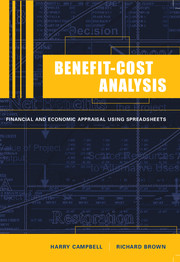Book contents
- Frontmatter
- Contents
- List of figures
- List of tables
- Preface
- Acknowledgements
- 1 Benefit-Cost Analysis: Introduction and Overview
- 2 Investment Appraisal: Principles
- 3 Investment Appraisal: Decision-Rules
- 4 Private Benefit-Cost Analysis: Financial Analysis
- 5 Efficiency Benefit-Cost Analysis
- 6 Calculating the Net Benefits to the Referent Group
- 7 Consumer and Producer Surplus in Benefit-Cost Analysis
- 8 Valuing Traded and Non-traded Commodities in Benefit-Cost Analysis
- 9 Incorporating Risk in Benefit-Cost Analysis
- 10 The Social Discount Rate, Cost of Public Funds, and the Value of Information
- 11 Weighting Net Benefits to Account for Income Distribution
- 12 Valuation of Non-marketed Goods
- 13 Economic Impact Analysis
- 14 Writing the Benefit-Cost Analysis Report
- Appendix 1 Case Study Assignment
- Appendix 2 Discount and Annuity Tables
- Index
9 - Incorporating Risk in Benefit-Cost Analysis
Published online by Cambridge University Press: 05 September 2012
- Frontmatter
- Contents
- List of figures
- List of tables
- Preface
- Acknowledgements
- 1 Benefit-Cost Analysis: Introduction and Overview
- 2 Investment Appraisal: Principles
- 3 Investment Appraisal: Decision-Rules
- 4 Private Benefit-Cost Analysis: Financial Analysis
- 5 Efficiency Benefit-Cost Analysis
- 6 Calculating the Net Benefits to the Referent Group
- 7 Consumer and Producer Surplus in Benefit-Cost Analysis
- 8 Valuing Traded and Non-traded Commodities in Benefit-Cost Analysis
- 9 Incorporating Risk in Benefit-Cost Analysis
- 10 The Social Discount Rate, Cost of Public Funds, and the Value of Information
- 11 Weighting Net Benefits to Account for Income Distribution
- 12 Valuation of Non-marketed Goods
- 13 Economic Impact Analysis
- 14 Writing the Benefit-Cost Analysis Report
- Appendix 1 Case Study Assignment
- Appendix 2 Discount and Annuity Tables
- Index
Summary
Introduction
If benefit-cost analysis is to assist in the decision-making process the analysis must be conducted in advance of the project being undertaken. This means that the value of none of the variables involved in the analysis can be observed, but rather has to be predicted. Risk and uncertainty are always associated with predictions about the future and should be taken into account in the benefit-cost analysis. Since risk and uncertainty impose costs on decisionmakers, these costs need to be assessed and measures taken to reduce them if possible. One way of reducing risk and uncertainty is to acquire additional information mdash; what a benefit-cost analysis does mdash; and the value of information is briefly discussed in Chapter 10. The present Chapter discusses the related concepts of risk and uncertainty.
Risk and Uncertainty
In the preceding Chapters, exercises and case studies we have assumed that all costs and benefits to be included in a cash flow are known with certainty. While this assumption might be acceptable in the context of project evaluation where the analyst is undertaking an ex post assessment of what has already occurred, it is clearly an unrealistic assumption to make where the purpose of the analysis is to undertake an appraisal of proposed projects where one has to forecast future cost and benefit flows. The future is uncertain: we do not know with certainty what the future values of a project's costs and benefits will be.
- Type
- Chapter
- Information
- Benefit-Cost AnalysisFinancial and Economic Appraisal using Spreadsheets, pp. 194 - 220Publisher: Cambridge University PressPrint publication year: 2003



